The Fall of Johnny Football

KERRVILLE, Texas — For 73 days last spring, Johnny Manziel woke up atop a mountain. In evergreen-thick acres of pastoral Pennsylvania, Manziel was, for the first time in his life, secluded.
The Browns quarterback had entered Caron Treatment Center for undisclosed issues, and when he was discharged in April—just in time for the first offseason workout of 2015—those around him saw a different Manziel. He was more focused, especially when it came to football. The Browns training staff noted that he looked less bloated. His skin was even glowing.
For his second season in Cleveland, Manziel did not renew his lease on an apartment at The 9, the swanky downtown high-rise bustling with young professional athletes and boasting its own rooftop lounge. Instead he rented a house 25 minutes away, in the suburbs. Manziel also reintegrated into the NFL by adding structure, asking his high school offensive coordinator, 55-year-old Julius Scott, to move in as something of a life coach.
With a post-rehab glow and Scott at the helm, coaches noticed Manziel was studying the playbook more. Teammates noticed he was drinking less. By July, coaches and friends had the sense that Manziel had his life under control.
By the end of the summer, Scott had been dismissed. By midseason, the quarterback had fallen back into old habits. It’s a familiar pattern: Manziel straddles the line between becoming the professional football player many believe he can be, and the kid from Kerrville who can’t help but sabotage himself.
Manziel’s career has plunged to new depths after another year of off-field recklessness. Just 22 months after drafting him as their presumed franchise quarterback, the Browns have officially moved on, cutting Manziel last Friday. (His final stat line in Cleveland: 14 games, 57.0 percent completion rate, seven touchdowns, seven interceptions, seven fumbles.) An accusation of an ugly assault hangs over him; according to an affidavit, ex-girlfriend Colleen Crowley said that on Jan. 30 Manziel struck her so hard her eardrum ruptured. A Dallas grand jury is contemplating an assault charge.
He has been dropped by his agent, Erik Burkhardt, and his marketing team. As recently as early January, league sources say at least two teams—one being the Cowboys—had legitimate interest in Manziel. That was before the alleged assault on Crowley. Now, those same sources say that unless Manziel seeks treatment, he’s “untouchable.” His actions since Crowley’s accusations surfaced—chugging bottles at nightclubs from Miami to West Hollywood, dancing at a strip club—demonstrate such apparent disregard, it raises the question: If he never plays football again, does he even care?
Neither Manziel nor his parents responded to multiple requests for comment. Denise Michaels, Manziel’s publicist, also declined an interview request on Manziel’s behalf. Family lawyer Brad Beckworth said he had “no comment or interest in discussing the matter.” But many who have spent time in Manziel’s inner circle agreed to speak to The MMQB, believing it was important to accurately depict the tale of the Manziel conundrum. Each person interviewed—Browns and Texas A&M coaches and teammates, close friends, family friends and lawyers—expressed frustration with Manziel, sharing stories that depicted a lack of commitment and a culture of enablement. They all wondered where it went wrong. They also wonder what else could have possibly been done to save Manziel from himself. As one of his former coaches says: “When he had LeBron James as a mentor, texting him all the time, hanging out at his house watching football, and Johnny didn’t listen to his advice? That’s when I knew he had a problem.”
Over the years, Manziel has gravitated toward trouble. “The thing is,” says Steven Brant, one of Manziel’s best friends from high school, “we’ve been through so much. But no matter what happens, we always seem to figure it out. He always seems to end up OK.”
This time might be different. According to the Dallas Morning News, Manziel’s father, Paul, tried getting his son to enter a rehab facility in January, shortly after Johnny’s 23rd birthday. When his son refused, Paul Manziel told the paper: “I truly believe if they can’t get him help, he won’t live to see his 24th birthday.”
* * *
It was the biggest party night of the year, but friends say Manziel wasn’t feeling up to it. Perhaps he was still woozy from a concussion as the beleaguered quarterback announced he would not be going out on New Year’s Eve. And so his friends stayed in too, lounging in Manziel’s three-bedroom home in a leafy Cleveland suburb. They watched Casino, then Sicario, then Spectre, though Manziel nodded off several times.
Such movie nights are not uncommon for Manziel. Those close to him describe patches when the quarterback “wants to get right.” He will re-commit himself to football, sequester himself from the spotlight and, when he has free time, binge on DVDs.
Whether this was such a spell or not, friends thought nothing of Manziel sleeping well into the New Year. Three days later, on the eve of Cleveland’s finale for another lost season, he vanished. Several people, including Cleveland coaches, called him repeatedly, each time reaching his voicemail. Manziel, it turns out, was in Las Vegas, sporting a blonde wig, glued-on mustache and hoodie while telling people his name was “Billy.”
Browns coaches were livid, sources say, but not altogether surprised. They issued warnings to Manziel several times during the season, including before their bye in Week 11 when, according to several sources, head coach Mike Pettine summoned the quarterback into his office and said, bluntly, Don’t do anything that will embarrass us. Manziel would fly to Austin, where he partied for two straight nights. A DJ captured him on video, which surfaced weeks later.
“The moment he saw that video on Twitter,” a friend says, “His reaction was literally, ‘F---!’ He knew he screwed up. He knew he shouldn’t have done that.” But even before that week, Manziel’s tenure in Cleveland was already doomed.
* * *
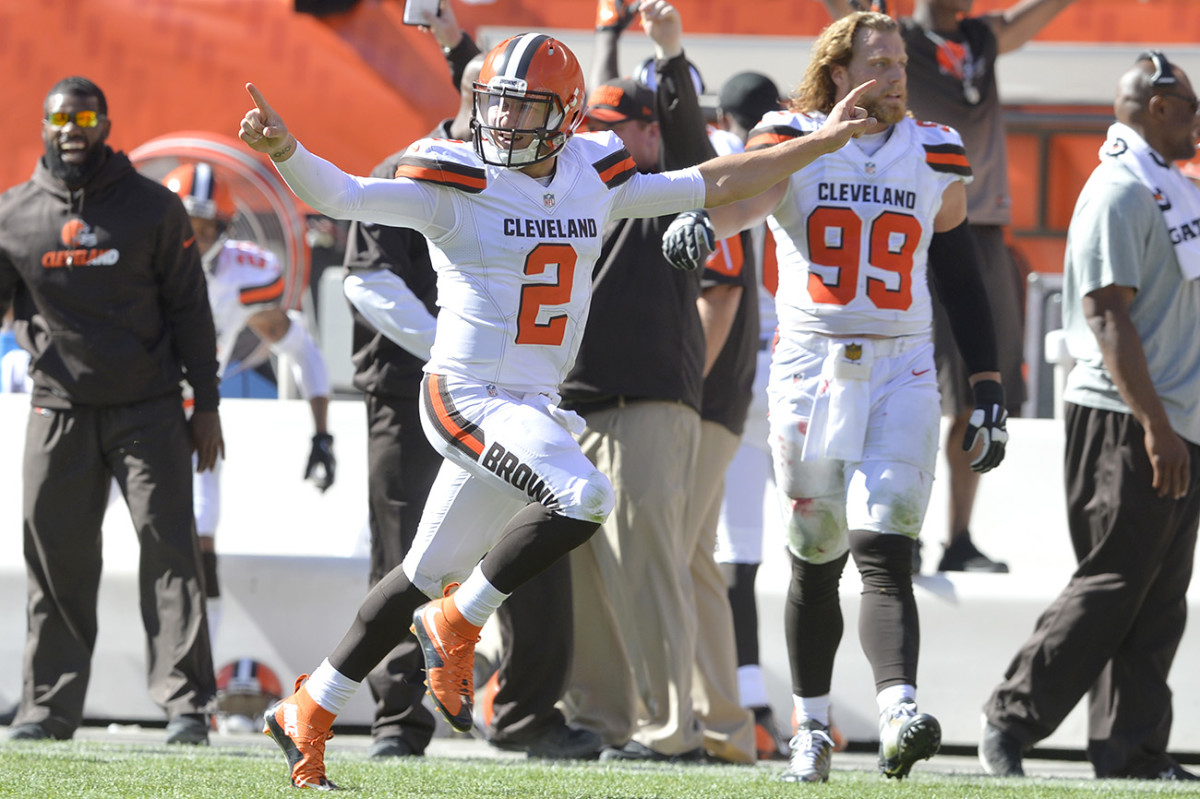
It was Week 2, early enough in the year that optimism in Cleveland—however sparse—was still intact. And it was the rare Sunday afternoon with the nation’s eyes trained on FirstEnergy Stadium. The visiting quarterback, Titans rookie Marcus Mariota, had had a dazzling debut one week earlier, and the football world was eager to see his encore performance. But this day would belong to the Heisman winner on the home sideline.
When Josh McCown was concussed in the Browns’ season opener against the Jets, Manziel came off the bench and provided the kind of erratic play that plagued his rookie season a year earlier. However, on this Sunday, Manziel exuded an electricity that evoked his Texas A&M career. On Cleveland’s second offensive snap, he connected with speedy wideout Travis Benjamin for a 60-yard touchdown. But the reason for America’s fascination with Manziel could be distilled down to one play, his last of the game. With three minutes remaining and the Browns up 21-14, Manziel lined up in the shotgun. Titans linebacker Brian Orakpo came free off the edge, triggering Cleveland’s scramble drill: Receivers abandoned routes and raced for open field. Manziel spun to his left, ran for the sideline and launched a long spiral. On-target, again; Travis Benjamin, again, this time for a 50-yard score to seal the victory. The Dawg Pound was whipped into a frenzy. Manziel, arms outstretched, sprinted downfield in celebration. The moment seemed to usher in a new era of Cleveland Browns football.
Pettine later called the play “vintage Manziel.” On the sideline, offensive coordinator John DeFilippo deadpanned: “Coaching is overrated.” Even his staunchest critics melted: ESPN analyst Merril Hoge reversed his longstanding reluctance to embrace Manziel, declaring him the Browns starter “without question.”
More importantly, Manziel believed the starting job was his. But when he arrived at the team facility on Wednesday, McCown had cleared concussion protocol, and Pettine issued unwavering support for the 14-year journeyman. According to sources, Manziel was incredulous. He was a first-round pick and had just led the Browns to their first win in 10 months. He had also done everything the Browns had asked of him the previous offseason—the rehab, the move to the suburbs, less drinking.
• CAN DEPODESTA FIX THE BROWNS: Tom Verducci on the Moneyball maven brought in to run the Browns
Perhaps the coming months would have played out differently if Scott had still been in Manziel’s life. He was one of the first people Manziel thanked in his Heisman speech. Scott was the coach who was unafraid to grab Manziel’s face mask and berate him for showboating. At the same time, Scott never left a conversation with Manziel without telling him he loved him. He had abruptly resigned from his job at a Texas high school for the chance to help Manziel get straight.
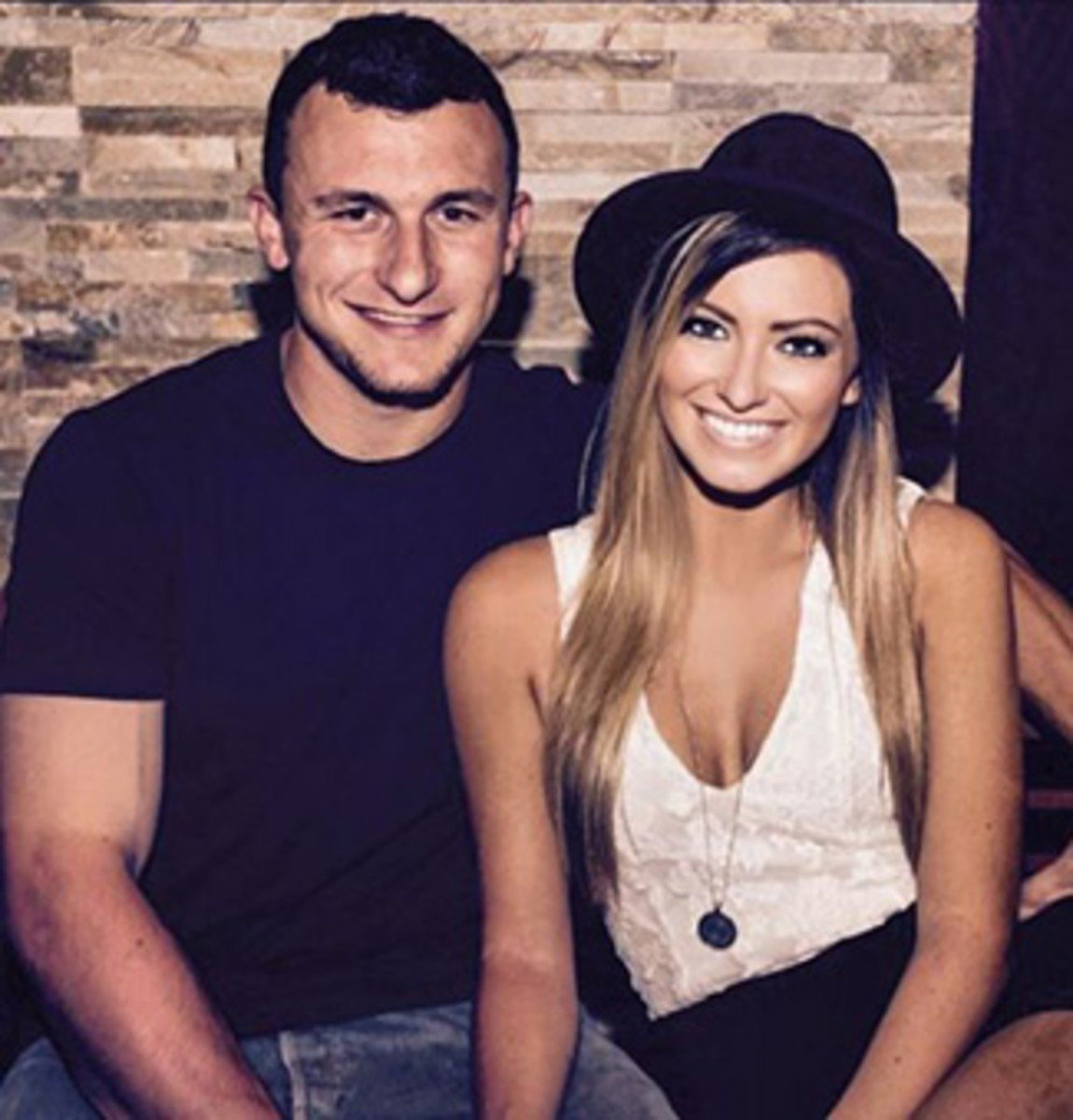
The plan had been for Scott to stay with Manziel through the 2015 season, an arrangement similar to that of MLB slugger Josh Hamilton and his personal handler, Shayne Kelley. Manziel offered Scott some financial compensation; Scott offered steadying companionship. Scott took his job seriously; friends say Manziel eventually found his presence overbearing. By training camp, Scott had gone back to Texas. (Scott declined a request to comment for this story.) Crowley moved in with Manziel soon after.
With no support system in place, the benching was a tipping point. Browns sources say this instigated Manziel’s downward spiral. Friends too, noticed that Manziel was disengaged after the Titans game, though they saw him regroup a few more times during the season. Before the Steelers game in Week 10, for example, Manziel was acting with confidence, as Pettine had just tapped him as the starter for a second consecutive game.
“If Johnny doesn’t have a carrot dangling in front of him, he resorts to his default,” says a friend. “And his default is not giving a s---.”
But the Tennessee game would prove to be one of the few highlights of Manziel’s Cleveland tenure. When reinserted as the starter for an injured McCown later in the year, Manziel was ineffective save for the occasional improvisational play.
He wanted to party again, so he did, often showing up late to the facility for meetings and, according to a Browns source, sometimes sleeping off hangovers in the back of equipment rooms. In October there was a police dash-cam video of an argument between Manziel and Crowley during which Crowley claimed that she had been hit “a couple of times” (she did not press charges, and the NFL did not impose discipline), there was the bye-week partying in Austin, there was “Billy Vegas,” and finally—and most seriously—there was the assault accusation levied by Crowley in January.
* * *
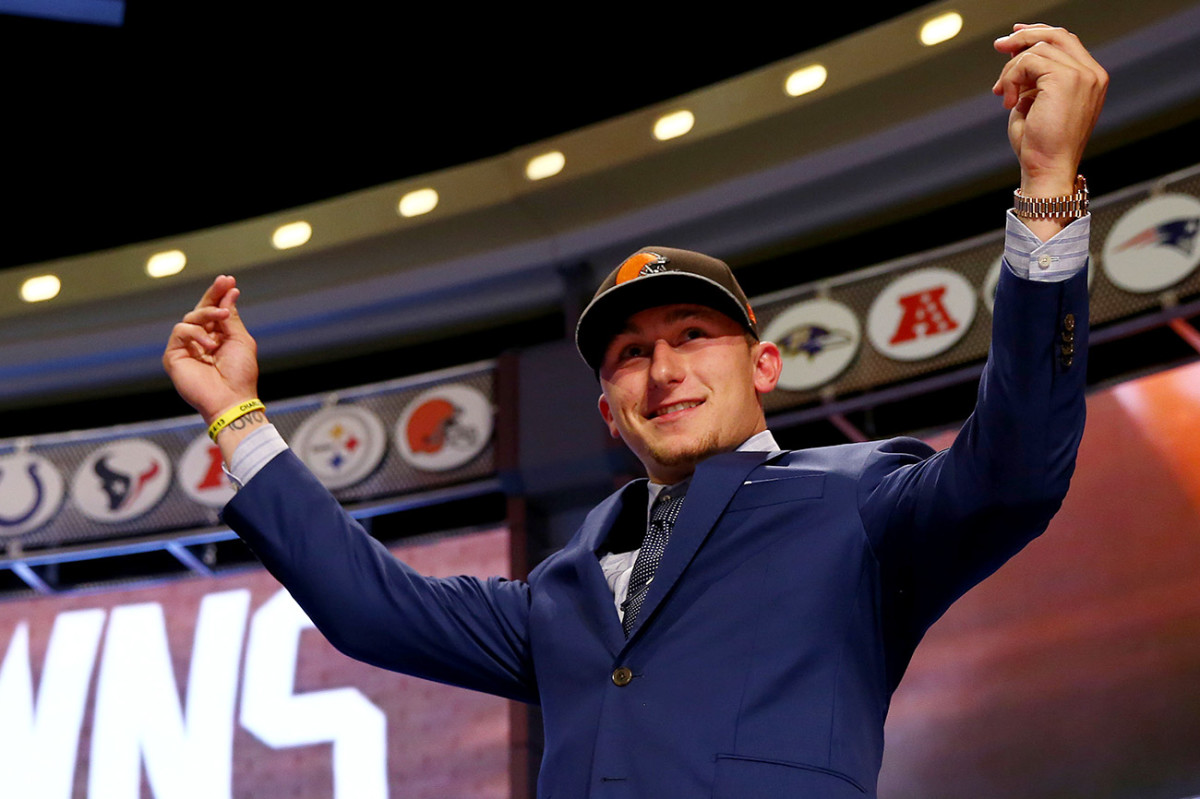
No Cleveland resident under the age of 50 has seen a hometown team win a championship in a major professional sports league, and the hapless Browns have been plagued by an especially cruel mix of heartbreak and dysfunction.
Manziel’s arrival in the spring of 2014 was reason enough to celebrate. In the 12 hours after the draft, the Browns sold more than 1,500 season tickets. The team began asking fans to register online to attend training camp. In July of that year, Manziel led the league in jersey sales.
But in hindsight, it’s fair to ask: Did the Cleveland Browns ever really want Johnny Manziel?
After an extended draft-night wait in the green room, Manziel—selected 22nd, Cleveland’s second pick of the first round—had taken the stage, flashed the money sign and stoked the Browns’ fan base. Afterward, the quarterback was scooped up in a car at Radio City Music Hall and escorted to a private party: no media, no fanfare, just close friends. Along the way, he, childhood friends Brant, Deron Belford and his old coach, Scott, made a pit stop at a Lids store in Midtown. They bought every piece of Browns merchandise in the shop.
While Manziel and fans celebrated, one Browns assistant says the coaching staff was less thrilled with a selection that had seemingly come down from ownership.
“Johnny never really felt like the coaches wanted him there,” a close friend says.
That feeling became more defined as the season wore on. Manziel had never had a playbook before he entered the NFL—Texas A&M issued its players weekly game plans—and he barely studied it. He struggled through weekly quarterback tests. At practice, the offense would run a set of 10 scripted plays, with Manziel (as the No. 2 QB) running two of them. He would brush up on those two plays, and only those two plays.
“[So] when he was thrust into [the starter’s] role, it became very clear he had no idea what was going on,” says a former Browns coach. “He went out there and had no clue.”
When incumbent starter Brian Hoyer was injured and Manziel was asked to do more, he’d often blank. Offensive coordinator Kyle Shanahan—a “system first, players second” coach—simplified his packages for Manziel so much, one Browns source says, “you or I could have lined up under center.”
Manziel was often detached at practice. On an especially cool afternoon, he remarked: “I bet it’s nice in Dallas right now.” That irked many in the organization, including some teammates, though he was never unpopular in the locker room. Far from it. Many players seemed to gravitate towards Manziel because he was charming and cool. Manziel is loyal, picking up the tab anytime a friend visited Cleveland, buying friends Rolex watches “just because” or taking time to engage in conversation with a teammate’s or coach’s kids who were fans. If he didn’t like someone, he let it be known.
“That’s the thing most people don’t understand about Johnny,” a Browns source says. “His teammates all love him, and stand up for him.”
Manziel’s behavior in Cleveland was similar to his behavior at Texas A&M. He would stay in the film room for extra hours if the Aggies had a tough opponent, but if he was confident the Aggies would win, he would leave after the final whistle of practice. He was always in a class of his own.
A popular story in College Station is of an informal summer practice after his Heisman season. The summer was a whirlwind of meet-and-greets and rubbing shoulders with A-listers for Manziel, who arrived to a session late. The moment he got there, he was mobbed by teammates who were excited to see him. Manziel jumped right into the 7 v. 7 drill, in the jeans he was wearing when he arrived, and led his team on a touchdown drive.
* * *
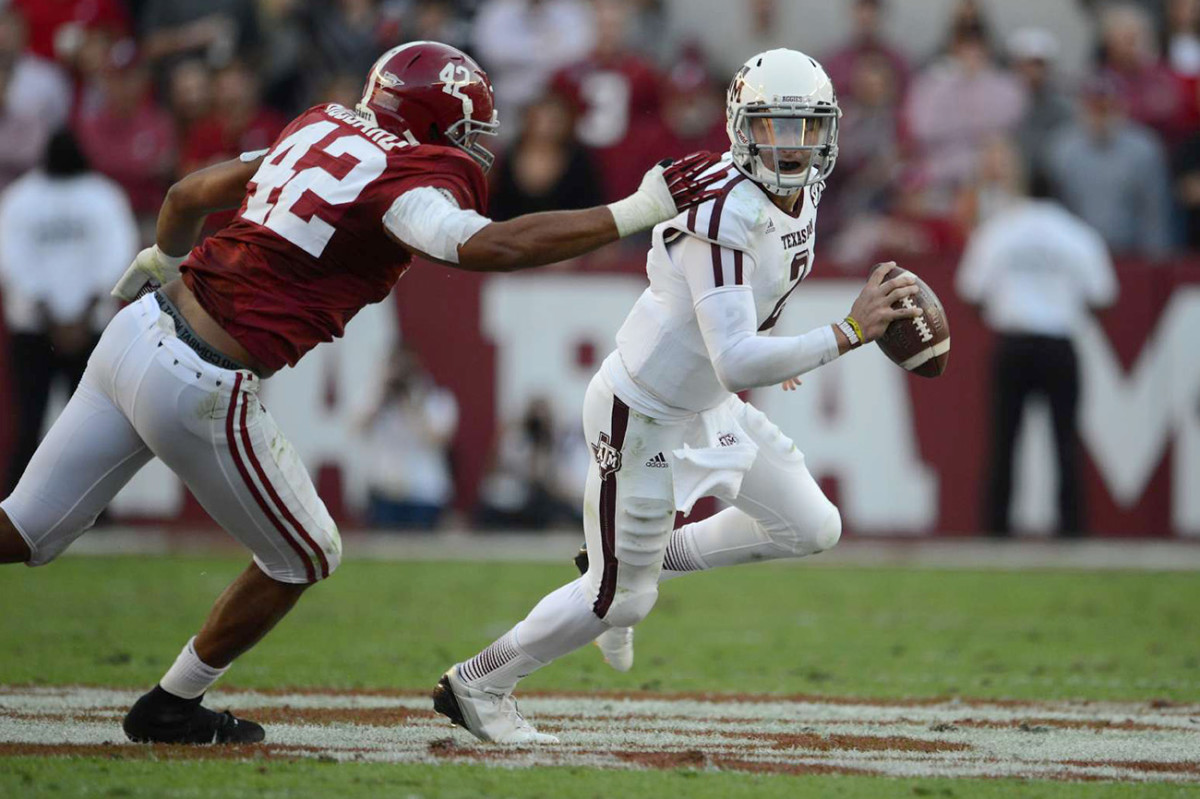
Johnny Manziel’s introduction to the college football world came by way of a shirtless booking photo. On the morning of July 29, 2012, Manziel woke up in a jail cell. Hours earlier, he and Brant were at a College Station bar. According to a police report, Brant said something that was taken by an African-American patron as a racial slur. Manziel tried to make peace, but according to the report he too was drunk, and began fighting with the man in what the report described as “mutual combat.” The police report notes Manziel “appeared to be so intoxicated he could not answer my questions about the incident except to tell me he wanted a ride home and was sorry.” He also showed police a fake ID. He was charged with disorderly conduct, failure to identify himself and possessing a false identification card.
The arrest was a blip on the national radar. The extent of ESPN’s coverage was a 300-word Associated Press wire story on its website. Even the local paper, The Eagle of Bryan, Texas, ran this headline: “Texas A&M freshman in line for quarterback position arrested.” Manziel was not a name worthy of display type.
It was a big deal to Kevin Sumlin, who had just taken the reins as the Aggies’ coach. Manziel’s parents convened for a series of meetings. The coach created a checklist for Manziel if he wanted to be a starter: community service, meet with a counselor, extra running and no partying. Manziel’s parents hired an attorney for the three misdemeanor charges (the disorderly conduct and false ID charges were dropped; Manziel pleaded guilty for failure to properly identify himself).
But five weeks later, Manziel heard from the school’s disciplinary board; he had been placed on “conduct probation,” which would include a ban from intercollegiate athletics from a semester (in this case, the 2012 football season). According to a source, Manziel was livid. Much as how he felt in the wake of that Titans victory three years later, he felt he had done everything asked of him.
As Manziel appealed the suspension, he began looking into junior colleges; if Texas A&M wouldn’t let him play, he would transfer. Sumlin wrote a letter to school officials vouching that Manziel had already faced punishment. On Aug. 14, the dean of student life overturned Manziel’s suspension. On Aug. 15, he was named Texas A&M’s starting quarterback.
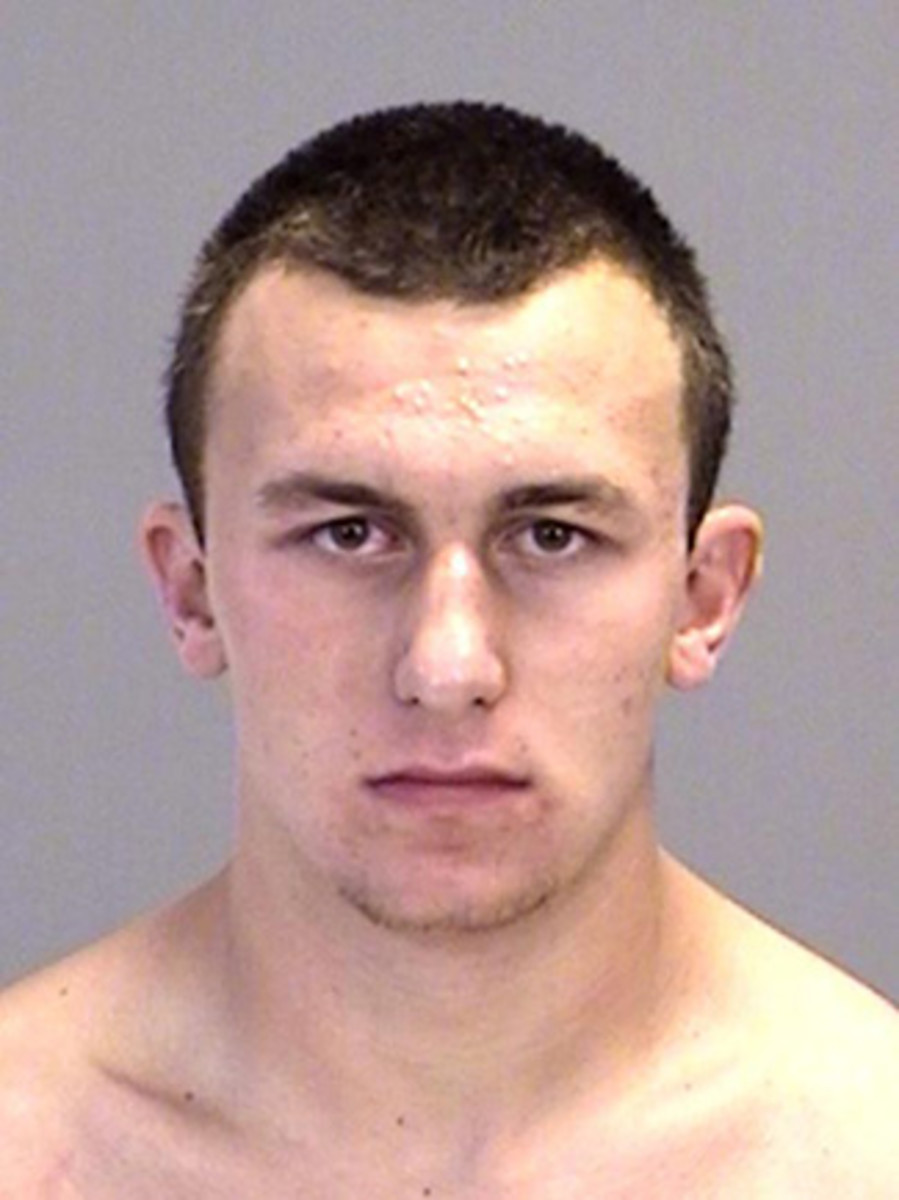
Within three months, Manziel’s world was turned upside-down. On Nov. 10, he led A&M to a shocking upset over top-ranked Alabama, in Tuscaloosa. When he returned to campus, Manziel had police escort him to class because he could barely walk a block without classmates stopping him. He had become the cult hero that had been missing from the college football landscape since Tim Tebow’s graduation. Except that Tebow’s ascent was more gradual—he was a prized recruit and saw part-time action as a freshman—and didn’t occur in the age of Twitter and Instagram.
Manziel-mania had arrived at the perfect time for Texas A&M, which was in the midst of a transformation, introducing itself to the SEC and undergoing a massive stadium renovation. On the field, Manziel flourished in chaos, extending plays and using his slight frame to evade defenders all over the field. “In a lot of ways, he was the anti-Texas A&M personality,” says Jason Cook, the Senior Associate Athletic Director who was directly involved with all marketing campaigns in 2013. “The university has always been known as tradition-rich and conservative. Johnny was flashy, he was confident, he was unpredictable. That’s something that attracted both Aggies and non-Aggies.”
A&M was flooded with phone calls not only from Sports Illustrated and ESPN, but from People Magazine and TMZ. The athletic department huddled for a strategy: They would assign one staffer whose sole responsibility was to handle all Manziel-related media requests. Part of the intrigue grew from a mystique: During Manziel’s Heisman season, Sumlin would not relent on his policy to bar first-year players from speaking to the media. Meanwhile, the university reaped $740 million in pledges and gifts in 2013, an all-time record for a public university.
The next summer, when allegations arose that Manziel had accepted money from a broker in exchange for autographs, an NCAA violation, his punishment netted out to a half-game suspension in the season opener against Rice. The Aggies led by seven at halftime; it took Manziel just 20 minutes of game time to stretch that lead to 24. And he flaunted it, celebrating touchdowns by miming an autograph and gesturing his now-famous money sign. He wasn’t benched until picking up a 15-yard taunting penalty in the fourth quarter, with the game out of reach.
The message was clear: Manziel was untouchable.
* * *
Manziel grew up in an affluent family, enriched for generations by the oil industry. When he was in seventh grade, the family moved from East Texas to Kerrville, 100 miles northwest of San Antonio. Tucked in the hills, it’s is a small town that welcomes placidity, seducing retirees with two museums, a folk festival and a tendency to pour tax dollars into golf courses. The status quo was interrupted in the summer of 2011, when one of the high school’s star athletes, Deron Belford, was indicted on three charges related to two separate accusations of sexual assault.
“Charges like this in a town like Kerrville?” says Mark Stevens, Belford’s attorney. “You bet this was a big case around here.” Belford, then 18, was one month away from enrolling at Texas State on a basketball scholarship. He pleaded not guilty to all three charges, but TSU revoked the offer (Belford, an all-state point guard, would never play college basketball).
According to Kerr County court documents, he was charged with sexually assaulting two females at two different parties, in 2010 and 2011. (The accusers each came forward months after the incidents occurred.) The Kerr County District Court tried the cases separately. The first trial began in April 2012. The 12-member jury was all female. The victim testified, describing how at a group get-together, her friends peeled off in pairs, of how she and Belford were alone in the back seat of his car, and how he forced himself on her.
Then the defense called in its star witness, and those in the courtroom that day recall an audible gasp when his name was announced: skyping from his College Station dorm room, Johnny Manziel.
The quarterback had only enrolled at Texas A&M that January, but he was legendary in Kerrville—during his senior year, his dazzling play attracted such crowds that school officials had to arrange shuttles from the mall parking lots for games. Manziel missed several quarterback meetings to skype with attorneys before the court date, which barely registered a pulse in Aggieland. The party where one alleged incident occurred was at Manziel’s parents’ house, and Belford was one of Manziel’s best friends; besides playing basketball, Belford was a standout wide receiver. Even still, the defense was somewhat surprised that Manziel agreed to participate, testifying for roughly 20 minutes while he was 200 miles away.
The jury entered deliberations the next day, and after just hours found Belford not guilty.
Belford wept when he heard the verdict. The second trial, scheduled for June and covering two charges, never happened: Belford entered a plea bargain after the district attorney reduced the two charges to one charge of simple assault. “He was able to move on with his life,” Stevens said. Until it unspooled again.
In 2013, after Manziel won the Heisman Trophy, he was feted in Kerrville. A ceremony in town was followed by a house party. Manziel, his parents, his friends and their parents attended, and alcohol flowed freely. Belford was drinking a Coors Light when a guest approached him: Keith Williams, a judge in town. “You’re not supposed to be drinking that,” the judge said.
A few weeks later Belford began a 131-day prison sentence for violating his probation. He also lost any chance of ever playing college basketball, all because he couldn’t resist grabbing a beer. For a young star athlete like Manziel who himself had been arrested less than a year earlier, his friend’s case would seem to be a pointed cautionary tale. Considering Manziel’s current predicament, he apparently never saw it that way.
* * *
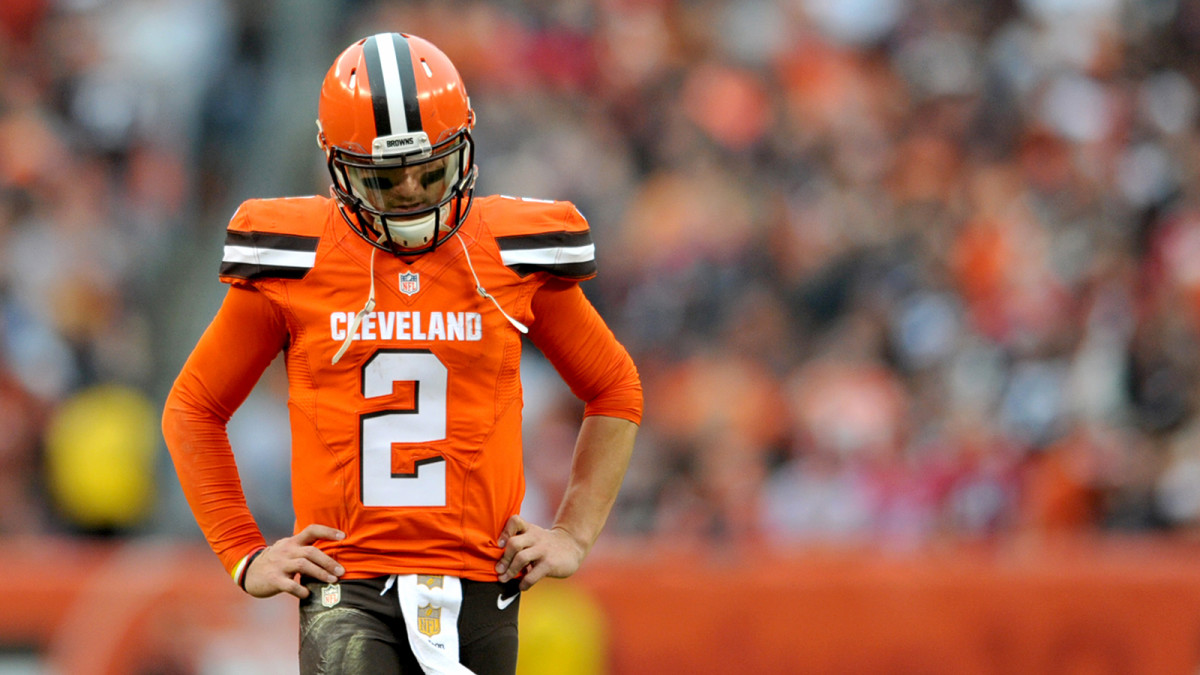
Those in the Browns organization believed that perhaps Julius Scott would have been able to keep Manziel focused and peel him away from a lingering entourage from Texas. Manziel is rarely alone. Friends say his call and FaceTime logs can reach double-digits by mid-afternoon. If he’s not around friends, he’s talking to them. Manziel’s own marketing team had tried to separate the quarterback from this group. On several occasions, they plopped the quarterback in front of a white board, mapping out the times he got in trouble and the people he was with when those incidents occurred.
Upon news of his release on Friday, his publicist released a statement on Manziel’s behalf:
“I’d like to thank the Browns for the opportunity they gave me—nearly two years ago, we all hoped that we were building what could be a championship team in Cleveland. I will always remember the support I received from the organization, my teammates and especially the fans.”
Some friends at Texas A&M wonder how Manziel’s life could have been different if he had stayed an extra year and worked through maturity issues in the confines of college.
People from Kerrville still speak glowingly of Manziel, and the excitement he brought to Tivy High, though visiting the town is a stark reminder that life moves on. In early February, storefronts were decorated with posters congratulating quarterback Cade Dyal, Tivy’s new leader in career touchdown passes.
Every person interviewed for this story, unprompted, issued a variation of the same sentiment: I still love the guy. They also all expressed worry over his latest partying binge. A few people close to Manziel questioned whether he even wants to play in the NFL anymore. Another suggested it’s impossible to predict the quarterback’s next career move “until he hits rock bottom.”
And that might be the scariest thing: No one is sure when things will get better for Johnny Manziel, but most everyone seems resigned to the fact that things are going to get worse.
